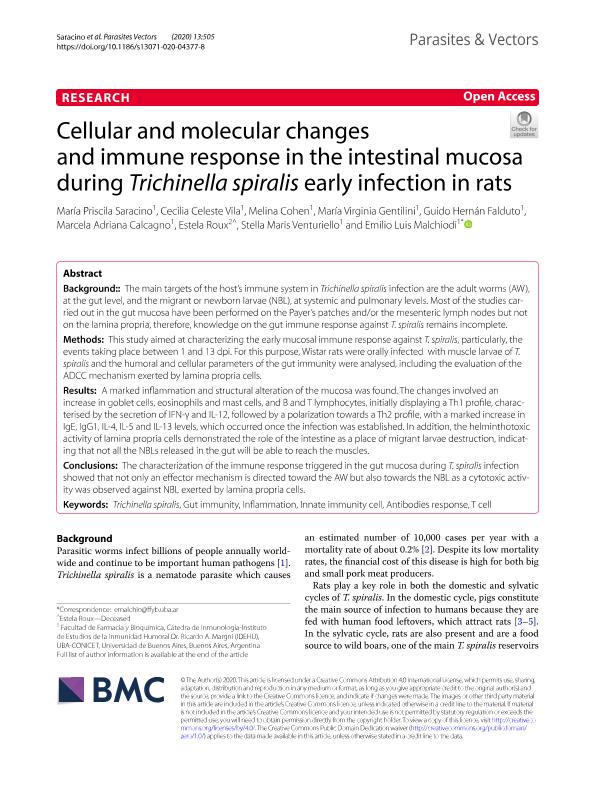Artículo
Cellular and molecular changes and immune response in the intestinal mucosa during Trichinella spiralis early infection in rats
Saracino, María Priscila ; Vila, Cecilia Celeste
; Vila, Cecilia Celeste ; Cohen, Melina
; Cohen, Melina ; Gentilini, Maria Virginia
; Gentilini, Maria Virginia ; Falduto, Guido Hernán
; Falduto, Guido Hernán ; Calcagno, Marcela Adriana; Roux, Estela; Venturiello, Stella Maris
; Calcagno, Marcela Adriana; Roux, Estela; Venturiello, Stella Maris ; Malchiodi, Emilio Luis
; Malchiodi, Emilio Luis
 ; Vila, Cecilia Celeste
; Vila, Cecilia Celeste ; Cohen, Melina
; Cohen, Melina ; Gentilini, Maria Virginia
; Gentilini, Maria Virginia ; Falduto, Guido Hernán
; Falduto, Guido Hernán ; Calcagno, Marcela Adriana; Roux, Estela; Venturiello, Stella Maris
; Calcagno, Marcela Adriana; Roux, Estela; Venturiello, Stella Maris ; Malchiodi, Emilio Luis
; Malchiodi, Emilio Luis
Fecha de publicación:
10/2020
Editorial:
BioMed Central
Revista:
Parasites and Vectors
ISSN:
1756-3305
Idioma:
Inglés
Tipo de recurso:
Artículo publicado
Clasificación temática:
Resumen
Background:: The main targets of the host's immune system in Trichinella spiralis infection are the adult worms (AW), at the gut level, and the migrant or newborn larvae (NBL), at systemic and pulmonary levels. Most of the studies carried out in the gut mucosa have been performed on the Payer's patches and/or the mesenteric lymph nodes but not on the lamina propria, therefore, knowledge on the gut immune response against T. spiralis remains incomplete. Methods: This study aimed at characterizing the early mucosal immune response against T. spiralis, particularly, the events taking place between 1 and 13 dpi. For this purpose, Wistar rats were orally infected with muscle larvae of T. spiralis and the humoral and cellular parameters of the gut immunity were analysed, including the evaluation of the ADCC mechanism exerted by lamina propria cells. Results: A marked inflammation and structural alteration of the mucosa was found. The changes involved an increase in goblet cells, eosinophils and mast cells, and B and T lymphocytes, initially displaying a Th1 profile, characterised by the secretion of IFN-γand IL-12, followed by a polarization towards a Th2 profile, with a marked increase in IgE, IgG1, IL-4, IL-5 and IL-13 levels, which occurred once the infection was established. In addition, the helminthotoxic activity of lamina propria cells demonstrated the role of the intestine as a place of migrant larvae destruction, indicating that not all the NBLs released in the gut will be able to reach the muscles. Conclusions: The characterization of the immune response triggered in the gut mucosa during T. spiralis infection showed that not only an effector mechanism is directed toward the AW but also towards the NBL as a cytotoxic activity was observed against NBL exerted by lamina propria cells.
Archivos asociados
Licencia
Identificadores
Colecciones
Articulos(IDEHU)
Articulos de INST.DE EST.DE LA INMUNIDAD HUMORAL PROF.R.A.MARGNI
Articulos de INST.DE EST.DE LA INMUNIDAD HUMORAL PROF.R.A.MARGNI
Articulos(ININCA)
Articulos de INST.DE INVEST.CARDIOLOGICAS (I)
Articulos de INST.DE INVEST.CARDIOLOGICAS (I)
Citación
Saracino, María Priscila; Vila, Cecilia Celeste; Cohen, Melina; Gentilini, Maria Virginia; Falduto, Guido Hernán; et al.; Cellular and molecular changes and immune response in the intestinal mucosa during Trichinella spiralis early infection in rats; BioMed Central; Parasites and Vectors; 13; 1; 10-2020; 1-19
Compartir
Altmétricas



